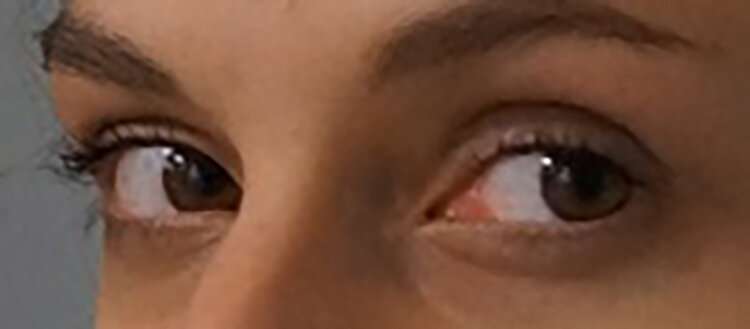
Eyes play an important role in social communication by expressing the intentions of our interlocutors, and even more so in times of pandemic when half of the face is hidden. But is this eye contact automatic and rapid? Is it based on a priority attentional reaction or, on the contrary, on a particular emotional reaction? To answer these questions, researchers at the University of Geneva (UNIGE), Switzerland, looked at the way we process human gaze, focusing on the estimation of the temporal duration of social interactions.
They discovered that when we make eye contact with another person, our attention is directly solicited, causing a distortion in our temporal perception. As a result, time seems shorter than it really is. On the contrary, this underestimation of time does not occur when we look at a non-social object. These results, to be read in the journal Cognition, will make it possible to develop a diagnostic tool to evaluate the mechanisms at work in people who are sensitive to social gaze, and then to act accordingly if disorders in the processing of social stimuli are detected, for instance in the case of autism or schizophrenia.
The way we look at others and the way we perceive others’ gaze have a major impact on social communication, a fundamental function called social cognition. “From an early age, we learn to decipher the feelings and intentions of our interlocutors through their eyes. Thus, meeting someone’s gaze is a very common social situation, but it always leads to a particular feeling,” notes Nicolas Burra, a researcher at the Psychology Section of the Faculty of Psychology and Educational Sciences (FPSE) at the UNIGE, and first author of the study. Two hypotheses are put forward to describe this situation: one says that eye contact with others directly generates an emotional reaction, without passing through our attention. The second hypothesis is that eye contact activates rapid and automatic attentional processing, which subsequently generates an emotional response.
Our perception of time influenced by emotion and attention
To test these hypotheses, the UNIGE researchers looked at the way we perceive time, which varies according to the emotional or attentional processing of the visual stimulus. “Indeed, it has been shown that when our emotional capacities have to process an unpleasant visual stimulus, for example if we are asked to evaluate the time of the appearance of a large spider, we will overestimate the time that passes, giving the impression that it is flowing more quickly than it actually does,” explains Nicolas Burra. Thus, our ability to evaluate time is disturbed by the emotional charge and accelerates. On the contrary, when the visual stimulus is processed by attention, the opposite effect occurs: focused on a stimulus that is very important for our attention, we underestimate the time that elapses and look at the object longer than we imagined. “By analyzing how long a person estimates that he or she has been looking at an object, we can determine whether the eye contact between two people is more attention-seeking or emotion-seeking,” says the Geneva-based researcher.
Deviated gazes versus eye contact
To assess the impact of eye contact on our perception of time, 22 participants observed a series of nearly 300 faces moving their eyes: either gazes establishing direct eye contact—eyes look into the void and then catch the participant’s gaze—or deviated gazes—the same eye movement is made, but the face and the participant’s gaze never meet. Over a period of 20 minutes, the participants subjectively assessed the different durations (between 1 and 2 seconds, close to everyday social interactions) of these social interactions. “While deviated glances do not distort our perception of time, we found that, on the contrary, when glances crossed, the participants systematically underestimated the duration of these eye contacts,” says Nicolas Burra. This experiment reveals that eye contact does not primarily impact the emotional system, but rather the attentional system that distracts us from our ability to evaluate time.
To assess these results, the UNIGE researchers carried out the same experiment with other participants, using non-social objects that made the same movements as the gaze. In that case, no distortion of time perception was observed. The same was true when a face was static. “It seems that not only a gaze, but also a movement is required,” the neuroscientist points out. The time-distortion effect was found, however, when the participants were shown only schematic eye movements or moving parts of the eyes without the rest of the face—a situation that is similar to social interaction with a mask. But it goes further, because this effect was also found in an online experiment with a hundred people, corroborating and generalizing the results obtained in the laboratory.
Eye contact captures attention
Source: Read Full Article
